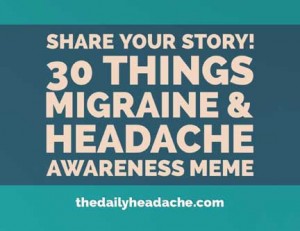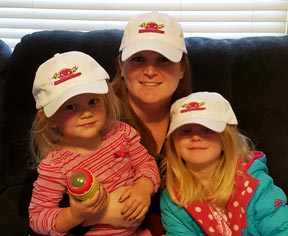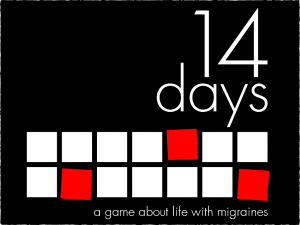 Raise migraine and headache awareness by sharing your 30 Things! Here’s how: Instructions and Submission Form for 30 Things for Migraine and Headache Awareness
Raise migraine and headache awareness by sharing your 30 Things! Here’s how: Instructions and Submission Form for 30 Things for Migraine and Headache Awareness
Curious about other readers’ stories? Here are all the 30 Things posts (in reverse chronological order) from this year and last.
30 Things posts have been coming in even though I haven’t promoted the project this year. Since readers are obviously eager to share their stories, I’m publishing this as a new call for submissions. I’ve updated the questions some from last year. All responses are welcome—whether you’ve never answered the 30 Things or did in 2015 and would like to take stock again this year. Here are my 2016 responses (and my 2015 ones):
Kerrie’s 30 Things About Life With Migraine
1. My diagnosis is: chronic migraine
2. My migraine attack or headache frequency is: daily (every time I eat unless I eat snacks that are 90% fat, no more than 270 calories, at least two hours apart, and contain a specific set of 10 foods)
3. The first migraine attack or headache I remember was: in class in the fifth grade. The teacher’s workroom off my classroom smelled of rose potpourri. I probably had attacks before that, but that’s the first one I know was a migraine attack. That smell still makes me panic nearly 30 years later.
4. My pain levels range from: Currently they range from a 2-4, with the very occasional 5. This is with a cocktail of preventive medications and supplements, continuous hormonal birth control, severe diet restrictions, and digestive enzymes. Before I found this regimen, the pain was regularly a 7-9 with some level 10 attacks (though I’m reluctant to label any of them a 10 for fear of tempting fate)
5. I was diagnosed in: 2002
6. My comorbid conditions include: depression, otherwise I’m remarkably healthy.
7. I take 21 pills (three different supplements/drugs) each day for prevention and 3 or 4 pills (two or three different drugs) to treat an acute attack
8. In addition to pain, other symptoms I experience include: fatigue and cognitive dysfunction are the worst; the list of other annoying, but not disabling symptoms is too long to tackle—it includes tooth pain, ear aches, cold feet, and frequent urination.
9. Treatments I have tried include: four dozen preventive meds and supplements, dietary changes, Botox, acupuncture, occipital nerve stimulator, Cefaly, Spring TMS, nasal surgery, TMJ surgery, a mouthguard, essential oils, organic food, acupressure, massage, Reiki, Chinese herbs (including scorpion tea), yoga, digestive enzymes… if you’ve heard of it, I’ve almost certainly tried it.
10. During a migraine attack or headache, I: have no energy and can’t think clearly.
11. My migraine attacks or headaches are triggered or get worse when: I eat or am exposed to odors. Currently, I get one almost every time I’m in a public place.
12. The most frustrating part about having migraine or a headache disorder is: not being able to function at the level I know I’m capable of.
13. Having migraine or a headache disorder causes me to worry about: every single thing I eat or drink (sometimes I even worry that water in a different city will be a trigger).
14. When I tell someone I have migraine or a headache disorder, they usually assume or say: “I’m sorry, me too” or “My friend/cousin/partner has migraine—it’s way worse than just a headache.”
15. When I see ads or articles about migraine or headache disorders, I think: the misinformation seems to be increasing exponentially.
16. My best coping tools are: mindfulness.
17. I find comfort in: reading, writing, my loved ones.
18. I get angry when people say: “It’s just a mindset” or “Think positive.”
19. I like it when people say: “You don’t have to talk about it if you don’t want to.”
20. Something kind a person can do for me during a migraine attack or headache is: ask me if I want company or to be left alone, and not ask a thousand times how I’m feeling.
21. The best thing a doctor has ever said to me about having migraine or a headache disorder is: “I will never give up on you.”
22. Having migraine or a headache disorder has affected my work/school life by: changing it entirely. I can only work sporadically, which is frustrating. But I’ve been pleased to discover that writing, which was a peripheral skill in my pre-disability world, brings me great joy.
23. The hardest thing to accept about having migraine or a headache disorder is: not having control.
24. Having migraine or a headache disorder has taught me: experiencing an emotion is a lot easier than running from it.
25. The quotation, motto, mantra, or scripture that gets me through hard days is: I’ve done the impossible before, I can do it again.
26. If I could go back to the early days of my diagnosis, I would tell myself: try a wide range of treatments before even considering surgery.
27. The people who support me most are: my awesome husband, family, friends, and readers
28. The thing I most wish people understood about migraine or headache disorders is: it’s nothing like getting an occasional headache.
29. Migraine and Headache Awareness Month is important to me because: the social stigma (from friends, family, coworkers, supervisors, teachers, and even health care providers) magnifies the physical symptoms.
30. One more thing I’d like to say about my migraine or headache disorder is: finding a therapist I click with has been invaluable. I have learned to get through a migraine attack without hating the fact that I’m having one, or stressing about everything I’m unable to do, or obsessing about what I could have done to trigger it.


 We’ve all wished we could place someone else in our migraine shoes so they can see what it’s really like to juggle the demands of the illness. 14 Days, a tabletop game, is attempting to do just that. In this two-person game, players try to manage their time and responsibilities in a two-week period never knowing when a migraine will strike. When a migraine hits, they then have to decide if it’s worth taking meds from a limited supply and what falls through the cracks.
We’ve all wished we could place someone else in our migraine shoes so they can see what it’s really like to juggle the demands of the illness. 14 Days, a tabletop game, is attempting to do just that. In this two-person game, players try to manage their time and responsibilities in a two-week period never knowing when a migraine will strike. When a migraine hits, they then have to decide if it’s worth taking meds from a limited supply and what falls through the cracks.